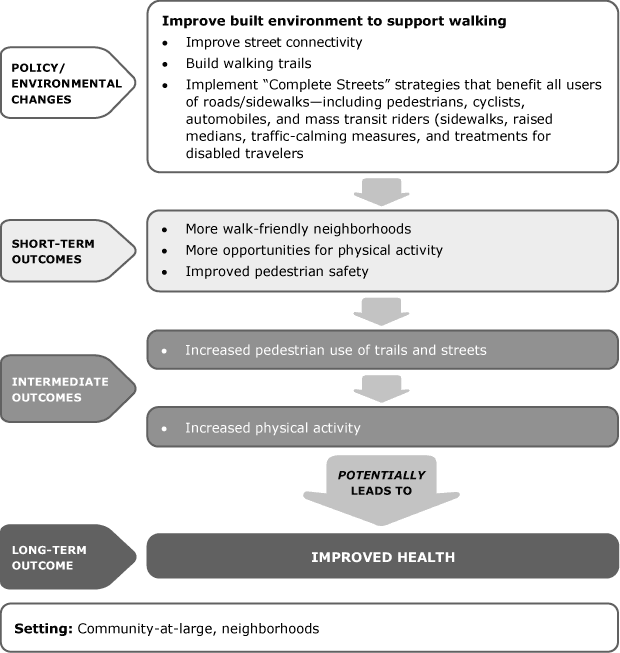Our Healthier Communities
Our Healthier Communities Initiatives are built on the concept that local communities can work together to give all community members healthy choices and support the pursuit of healthy lifestyles. More than 160 Ys are working in collaboration with community leaders to make changes in policies and the physical surroundings in those communities so that healthy living is within reach for individuals of all ages and backgrounds.
Improve Built Environment To Support Walking
When their environment provides safe, convenient places to walk, people are likely to walk more. Constructing walking trails and improving street paths has been shown to be effective in getting people physically active.
In general, constructing walking trails and improving street paths has been shown to be effective in getting people physically active, especially people who are at highest risk for inactivity. Variables such as younger age, more education, having physically active neighbors, having sidewalks or trails available, proximity to shops and using a mall for walking were associated with increased walking behaviors. Implementing a “Complete Streets” policy has been found to increase pedestrian safety and encourage walking and biking. In summary, making improvements to the built environment to support walking has the potential to increase residents’ physical activity levels and consequently, led to improved health.
References
- Addy, C.L., Wilson, D.K., Kirtland, K.A., Ainsworth, B.E., Sharpe, P., & Kimsey, D. (2004). Associations of perceived social and physical environmental supports with physical activity and walking behavior. American Journal of Public Health, 94(3), 440–443.
- Urban 4 Health, Inc. & The American Public Health Association. (2010). The hidden health costs of transportation. http://www.apha.org/NR/rdonlyres/F84640FD-13CF-47EA-8267-E767A1099239/0/HiddenHealthCostsofTransportationShortFinal.pdf. Retrieved November 15, 2010.
- Brownson, R.C., Baker, E.A., Boyd, R.L., Caito, N.M., Duggan, K., Housemann, R.A., Kreuter, M.W., Mitchell, T., Motton, F., Pulley, C., Schmid, T.L., & Walton, D. (2004). A community-based approach to promoting walking in rural areas. American Journal of Preventive Medicine, 27(1), 28–34.
- Brownson, R.C., Housemann, R.A., Brown, D.R., Jackson-Thompson, J., King, A.C., Malone, B.R., & Sallis, J.F. (2000). Promoting physical activity in rural communities. American Journal of Preventive Medicine, 18(3), 235–241.
- Evenson, K.R., Herring, A.H., & Huston, S.L. (2005). Evaluating change in physical activity with the building of a multi-use trail. American Journal of Preventive Medicine, 28(2S2), 177–185.
- Handy, S., Cao, X., & Mokhtarian, P. (2006). Self-selection in the relationship between the built environment and walking. Journal of the American Planning Association, 72(1), 55–74.
- Sallis, J.F., Bowles, H.R., Bauman, A., Ainsworth, B.E., Bull, F.C., Craig, C.L., Sjostrom, M., & Bergman, P. (2009). Neighborhood environments and physical activity among adults in 11 countries. American Journal of Preventive Medicine, 36(6), 484–490.
- Sharpe, P.A., Granner, M.L., Hutto, B.E., Wilcox, S., Peck, L., & Addy, C.L. (2008). Correlates of physical activity among African American and White women. American Journal of Health Behavior, 32(6), 701–713.
- National Complete Streets Coalition. (n.d.). Let’s complete America’s streets. Retrieved November 15, 2010, from www.completestreets.org.

More Healthy Living Strategies
-
Active Living Strategy #3
Healthy Living Strategies -
Active Living Strategy #4
Healthy Living Strategies -
Active Living Strategy #5
Healthy Living Strategies